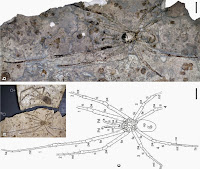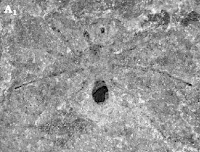Ray Spiders, Theridiosomatidae, are tiny (less than 2 mm) Spiders found in tropical and temperate regions around the world. They favor warm, moist, shady environments, and are mostly found in woodland, where they are recognizable for their cone-shaped webs.They have a limited fossil record, with specimens known from Tertiary Amber from Dominica and the Baltic (with the Dominican specimen being dubious) as well as a specimen from Cretaceous Burmese Amber and several specimens of a single species from the Transbaikal Mountains of Russia.
In a paper published in the journal Paleontological Contributions on 1 December 2014 David Penney of the Faculty of Life Sciences at the University of Manchester describes a new species of Ray Spider from the Late Cretaceous amber deposits of La Garnache in the Vendée department of France.
The new species is placed in the extant genus Baalzebub and given the specific name mesozoicum, in reference to its antiquity (i.e. coming from the Mesozoic Era). It is a 1 mm spider with eight eyes in two rows, the forward row being curved, the back row straight.
Baalzebub mesozoicum in Late Cretaceous amber from Vendée, France. Male specimen, scale bar is 0.5 cm. Penney 2014.
See also...
 A giant Spider from the Middle Jurassic Daohugou Biota. In 2011 Paul Seldon of the College of Life Sciences at Capital Normal University in Beijing, the Paleontological Institute and Department of Geology at the University of Kansas and the Natural History Museum in London, along with ChungKun Shih and Dong Ren, also of...
A giant Spider from the Middle Jurassic Daohugou Biota. In 2011 Paul Seldon of the College of Life Sciences at Capital Normal University in Beijing, the Paleontological Institute and Department of Geology at the University of Kansas and the Natural History Museum in London, along with ChungKun Shih and Dong Ren, also of... A Mygalomorph Spider from the Late Triassic of Italy. Mygalomorph Spiders (Tarantulas and related species) are considered to
be one of the most ancient groups of Spiders. They have two pairs of
book lungs (many other Spiders have lost a pair) and downward pointing,
rather than opposable fangs, again considered to be a...
A Mygalomorph Spider from the Late Triassic of Italy. Mygalomorph Spiders (Tarantulas and related species) are considered to
be one of the most ancient groups of Spiders. They have two pairs of
book lungs (many other Spiders have lost a pair) and downward pointing,
rather than opposable fangs, again considered to be a... Goblin Spiders from Cretaceous Amber. Goblin Spiders (Oonopidae) are one of the most abundant groups of
Spiders, with at least 600 and possibly over 1000 extant species
described, though this is generally considered to be a poor
representation of their diversity, since the Spiders are tiny (often...
Goblin Spiders from Cretaceous Amber. Goblin Spiders (Oonopidae) are one of the most abundant groups of
Spiders, with at least 600 and possibly over 1000 extant species
described, though this is generally considered to be a poor
representation of their diversity, since the Spiders are tiny (often...
Follow Sciency Thoughts on Facebook.

